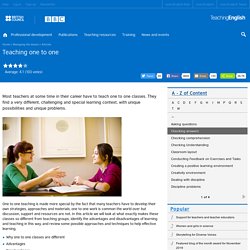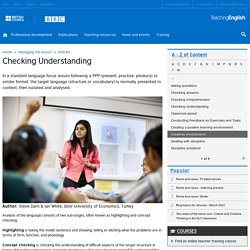

TeachingEnglish. Working in pairs and groups. The advantages of pair work and small group work Gives learners more speaking time Changes the pace of the lesson Takes the spotlight off you and puts it onto the children Allows them to mix with everyone in the group Gives them a sense of achievement when reaching a team goal Teaches them how to lead and be led by someone other than the teacher Allows you to monitor, move around the class and really listen to the language they are producing Pitfalls and how to avoid them You could lose control of the class. Set up a signal before you start, like a visual time out with your hands, so that they know when to stop. Managing: How to encourage and manage active involvement in group work.
Grouping students. Do you think about whether you’ve got a balance between pairs, groups, whole class and individual work? If you have activities for pairs and groups, do you let the students decide who they’re going to work with or do you decide? This tip looks at the advantages and disadvantages of the three main ways of grouping students.
They are, giving students the choice, random grouping and selecting the groups yourself. You’ll probably find that no one way will always be the best choice for a particular group, but that you’ll use all three ways at different times depending on your students and the activities you plan to do. Giving students the choiceThe chances are, if you let your students decide who they want to work with they will always stick to the same people. Paul Seligson, a well known TEFL author and teacher trainer, recently gave a workshop about classroom management at a conference here in Barcelona. By Jo BuddenFirst published 2008. Your Account Has Expired. Richard Smith, Amol Padwad - English teaching in difficult circumstances.
About the webinar This presentation aims to address the usually neglected needs of teachers working in ‘difficult circumstances’ (i.e. in low-resource classrooms, with large class sizes, in developing country contexts) and to help such teachers realise that they have the potential to take charge of their own development via collaboration with others in similar settings, locally and internationally.

Another aim is to show teacher educators how they can support colleagues to take the first steps in this process, despite constraints. The presentation is structured around two practical training tasks used successfully in a Hornby Regional School in Kathmandu on 'The Low-resource Classroom', which we illustrate using brief excerpts from video-recordings. Maximising learning in large classes. Maximising learning in large classes. TELC-net: The Teaching English in Large Classes research & teacher development network - Home. How to get started as an online teacher of English. Have you thought about teaching English online?
Emma Segev gives some practical tips and useful websites for getting started in one of our top five articles of all time, illustrated by artist Jamie Johnson. When I first started teaching in 2004, I was sceptical about the effectiveness of online teaching, but since then I have accumulated a lot of experience. I'd like to share with you a few things I've learned along the way. Getting started. Teaching one to one. One to one teaching is made more special by the fact that many teachers have to develop their own strategies, approaches and materials; one to one work is common the world over but discussion, support and resources are not.

Checking Understanding. Analysis of the language consists of two sub-stages, often known as highlighting and concept checking.

Highlighting is taking the model sentence and showing, telling or eliciting what the problems are in terms of form, function, and phonology. Concept checking is checking the understanding of difficult aspects of the target structure in terms of function and meaning. Concept checking is vital, since learners must fully understand the structure before any intensive practice of form and phonology is carried out. Connected speech. Recently however, there has been a shift of focus towards the other systems operating within phonology, which may be more important in terms of overall intelligibility. What connected speech is How this affects native and non-native speakers Aspects of connected speech Working on weak forms Conclusion What connected speech is "English people speak so fast" is a complaint I often hear from my students, and often from those at an advanced level, where ignorance of the vocabulary used is not the reason for their lack of comprehension.
When students see a spoken sentence in its written form, they have no trouble comprehending. Why is this? The reason, it seems, is that speech is a continuous stream of sounds, without clear-cut borderlines between each word. Phonemic chart. The Pronunciation Blog - Adrian Underhill's Pronunciation Site. Vocabulary activities. Using students' first languages in the classroom. Summary: Using students' first languages in the classroom Whether it is better to use the students' first language (L1) in class or have an English-only policy is something that has been much debated and that has seen many changes of fashion over the years.
It seems, therefore, that the only sensible reaction an individual teacher can take to this controversial subject is to neither accept nor reject the use of L1, but simply to search for an ideal level of its use in each individual class- maybe changing its use as the class progresses in level or changes in other ways. Interview with Rod Bolitho Q9: Is there still a role for translation in ELT classroom?
Asking questions. Questioning is crucial to the way teachers manage the class, engage students with content, encourage participation and increase understanding. Typically, teachers ask between 300-400 questions per day, however the quality and value of questions varies. While questioning can be an effective tool, there is both an art and science to asking questions. Every question demands a response (except in the case of requests and suggestions), so that questions inevitably generate communication.
Error Correction 1. Therefore the aim of this article is not to be prescriptive, but to highlight some key areas.

It is in 2 parts. In the first part we look at ... Teens classroom rules posters - Smart white. These posters are designed to be used on your classroom walls with teenage learners aged from 13 years old. Kids classroom rules posters - Under the sea. Kids classroom rules posters - Under the sea. English Skills - Listening. English Skills - Reading. Watch grammar videos. Improve your English grammar and vocabulary. LearnEnglish Teens. English songs, stories and videos for kids. Reading practice for kids. English grammar videos for kids. Www.tubequizard.com.
A Task-based approach. This article also links to the following activity.Try - Speaking activities - Task-based speaking - planning a night out Present Practice ProduceThe problems with PPPA Task-based approachThe advantages of TBLConclusion Present Practice Produce (PPP) During an initial teacher training course, most teachers become familiar with the PPP paradigm. A PPP lesson would proceed in the following manner. First, the teacher presents an item of language in a clear context to get across its meaning. This could be done in a variety of ways: through a text, a situation build, a dialogue etc.Students are then asked to complete a controlled practice stage, where they may have to repeat target items through choral and individual drilling, fill gaps or match halves of sentences.
The problems with PPP It all sounds quite logical but teachers who use this method will soon identify problems with it: Why are so many of our teachers and schools so successful? John Hattie at TEDxNorrkoping.